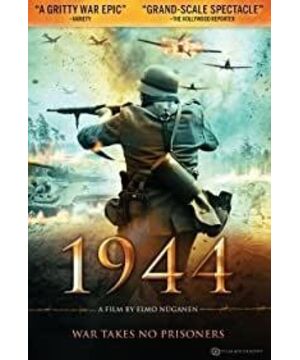Estonia, as one of the three Baltic countries of the former Soviet Union, is not well known. The country's process of joining the Soviet Union was not only reluctant, but also at the cost of many senseless sacrifices. [1944] not only restores the war scene at that time, but also describes the Estonians when the war came in 1944, and its reflection on the war is even more commendable. During World War II, Estonia became the forefront of the conflict and struggle between the two centralist powers in the Soviet Union and Germany. This weak nation-state had to split into two factions in the cracks, joining the German SS and the Soviet Red Army respectively, and finally fought on the battlefield. The film does not have a single protagonist, but is described from both sides of the war, which is a novel way of narration. Indeed, both sides of the conflict in the film are Estonians, but the compatriots have become enemies for political and other reasons. At the end of the film, one by one Estonian youth died in the war, which is unavoidable and saddened by the fate of the weak nation-state under the struggle for power. As a Chinese, after watching this film, you should also reflect on it. When facing our Taiwanese compatriots, don't talk about the unity of force at all times, and your palms and backs are full of flesh.
Say a few memorable viewing details:
1. Since the German army could only have Germans serving, the Estonians joined the German SS. The details of the movie's costumes are exquisite. The camouflage uniforms worn by the SS Estonians were not equipped until the end of World War II. This camouflage uniforms are limited, and not all soldiers in the film are wearing them.
2. The Romanian flag is embroidered on the sleeves of the SS, and the SS from the Netherlands are also included in the combat mission with them. It is enough to see the Nazi conscription strategy of World War II and the situation that the German soldiers were stretched in the later period of the war. This is also illustrated by the five captured child soldiers at the end of the film.
3. The car appears several times in the film. There are two occupants of the sedan, who obey their own beliefs and act as preachers. From the attitudes of the soldiers on both sides to them, it is enough to see their true mentality towards the two episodes of Sood. The Nazi who came to the SS barracks handed out a photo of the Führer and emphasized that Estonians and Aryans share the same ancestry. But he didn't get a good face from the frontline fighters. They fully expressed their contempt for Hitler, the German leader. This detail is enough to explain that the purpose of Estonia's participation in the SS is not to believe in Nazism and the rhetoric of the higher Aryan nation, but to simply protect its own country and people. On the other hand, this political official from the Soviet Union, who came to supervise the war at the beginning, always used military courts to scare officers and soldiers who were unwilling to shoot at their compatriots. Everyone dared not speak out against him. Later, he played tricks of power tricks to seduce and bribe and alienate him. Later, he ordered to shoot the prisoners of his own nation, and the officers and soldiers couldn't bear to shoot them. This official symbolized the tyranny and oppression of the Soviet regime. His death symbolized the revolt of the Estonians. I believe this is also the truest thought in the minds of the vast majority of Estonians.
4. After the protagonist, Sergeant Su Fang, shot and killed Carl in the second half, he saw the information recorded in Carl's notebook that they used to live together, so he decided to deliver the letter for him. And they met Carl's sister at first sight and their feelings warmed up. The sister told an important detail. The person who forced their family to separate in person was called Jotu. When the sergeant left, he was asked his name, and he made up a surname, but the scene where the Soviet political officials and him were alone revealed that the sergeant's father was Yotu who cooperated with the Soviets.
5. Sister Carl told the sergeant in the church that she chose to forgive the person who broke up their family, that is, the father of the sergeant. This was related to the sergeant's final choice to save the child soldiers against his orders and repented to sister Carl in the letter.
6. The director borrowed two letters, namely Carl's letter and Sergeant's letter, to describe the suffering brought by the war to the Estonian people and the people's yearning for a better life.
Talk about an abrupt feeling when watching the movie: the theme of the movie was too abrupt when it was transferred from the SS side to the Soviet side. If you can simply explain the Soviet side's clues before, it will be more understandable later.
Overall, the film is well-made, with realistic and detailed details of the battlefield scenes. The film does not praise either side, but describes the Estonians on both sides of the war, showing the cruelty of the war and the light of humanity. The fly in the ointment is that this kind of editing is more like the first and the second, and as a movie within two hours, it is a little abrupt. As a small country that is usually not familiar to Chinese audiences, it is worthy of 5? support for such a high-level war reflection film.
View more about 1944 reviews











